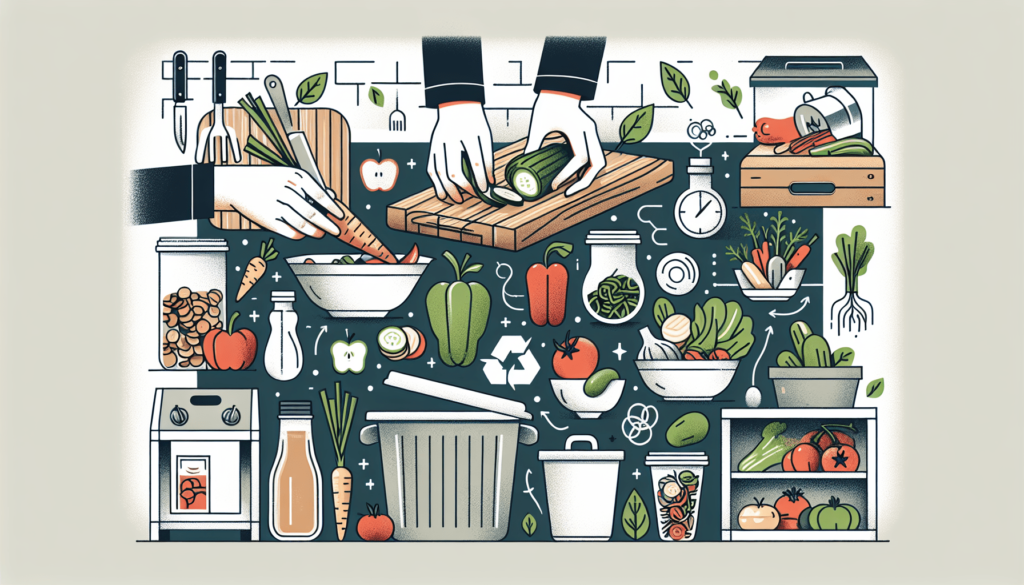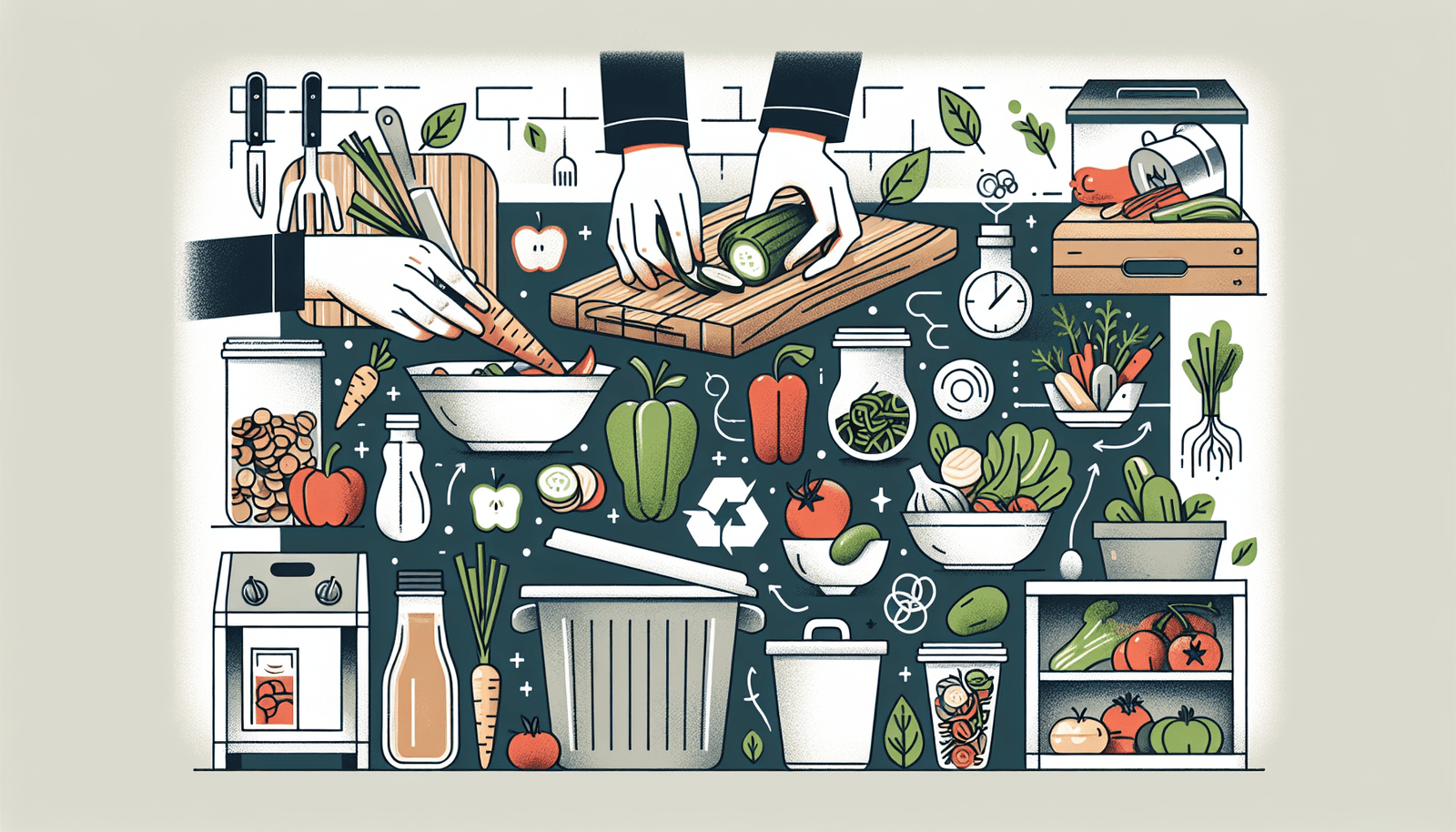In the hustle and bustle of daily life, it’s easy to forget about the food lurking in the depths of your refrigerator or the produce that’s just a day away from spoiling. But fear not, because you can become a Food Waste Warrior right in your own kitchen. This article is here to provide you with seven creative hacks that will drastically reduce the amount of food waste in your home. From clever storage tricks to inventive recipes, these tips will not only help you save money but also contribute to a more sustainable future. So grab your apron and get ready to embark on a journey towards a waste-free kitchen! In the vibrant world of healthy living, where food becomes your medicine and prevention plays a starring role, it’s important to not only focus on the nutrients in the food we eat but also on reducing food waste. Food waste not only impacts the environment but also our wallets. By implementing some simple strategies and creative hacks, you can become a Food Waste Warrior in your kitchen. Let’s explore seven effective ways to reduce food waste and make the most out of the ingredients you have.

1. Meal Planning
Meal planning is a crucial step in reducing food waste. By planning your meals for the week ahead, you can ensure that you only buy the necessary ingredients, minimizing the chances of food going to waste. Take some time each week to sit down and plan your meals. Consider what ingredients you already have and how you can incorporate them into your meals. This will not only save you money but also help you make use of what you already have in your pantry.
Once you’ve planned your meals, create a grocery list. Having a grocery list will keep you focused when you’re at the store and prevent you from buying unnecessary items. Make sure you check your pantry and fridge before heading to the store to avoid buying duplicates of items you already have. When making your list, think about the quantity of ingredients you need for each recipe to prevent overbuying and potential waste.
When you’re at the store, shop smart. Be mindful of expiration dates and opt for items with a longer shelf life. Choose fresh produce that can be stored for longer periods, such as root vegetables and citrus fruits. Additionally, try to buy items in bulk when it makes sense, as this can often be more cost-effective and reduce packaging waste.
2. Proper Storage
Proper storage is essential for maintaining the freshness of your ingredients and preventing food waste. Invest in airtight containers to store leftovers and pantry items. Airtight containers help prevent air exposure, which can lead to spoilage and waste. When storing leftovers, remember to label and date them so you can easily keep track of what needs to be consumed first. This will help you prioritize your meals and avoid any forgotten leftovers.
Fruits and vegetables also require proper storage to prolong their freshness. Some fruits release ethylene gas, which can cause other produce to ripen and spoil more quickly. Store ethylene-producing fruits, such as apples and bananas, separately from other fruits and vegetables. Additionally, consider investing in produce storage bags or containers designed to extend the shelf life of your produce. These containers help regulate moisture levels and keep your fruits and vegetables fresher for longer.
3. Use the Whole Ingredient
To reduce food waste, it’s important to maximize the use of every ingredient you have. Often, we discard parts of ingredients that are perfectly edible and packed with nutrients. By utilizing all parts of an ingredient, you can not only reduce waste but also add interesting flavors to your meals.
Vegetable scraps, such as carrot peels, onion skins, and herb stems, can be used to make flavorful stocks and broths. Collect these scraps in a container in your freezer until you have enough to make a batch of stock. Simply simmer the scraps with water, herbs, and spices, and strain the liquid. This homemade stock can be used as a base for soups, stews, and sauces.
When it comes to meat, aim to cook with the entire animal. Utilize cuts of meat that are less popular but still delicious, such as beef shanks or chicken thighs. These cuts not only tend to be more affordable but also contribute to reducing waste by typically being less sought after. Get creative with your cooking and explore recipes that make the most out of each part of the animal.
Stale bread often gets thrown away, but there are plenty of ways to repurpose it. Transform stale bread into breadcrumbs by toasting or drying it out and then pulsing it in a food processor. Homemade breadcrumbs can be used for coating meats, adding crunch to casseroles, or topping pasta dishes. Alternatively, stale bread can be cut into cubes and turned into croutons for salads or breadcrumbs for stuffing. Don’t let stale bread go to waste when it can add texture and flavor to your dishes.
4. Repurpose Leftovers
Leftovers are a common source of food waste, but with a little creativity, you can turn them into delicious new dishes. Instead of eating the same meal multiple times, repurpose your leftovers into something different. For example, leftover roasted chicken can be shredded and used to make chicken enchiladas or added to a stir-fry. Get creative and think about how you can transform your leftovers into completely new meals.
If you have leftover fruits that are becoming overripe, blend them into smoothies. Not only will this prevent them from going to waste, but it will also add a burst of flavor and nutrients to your smoothie. You can also freeze leftover fruits to use in smoothies or desserts at a later date. Simply slice the fruits into bite-sized pieces and store them in an airtight container or freezer bag.
Stale bread can also be repurposed into breadcrumbs or croutons, as mentioned earlier. Breadcrumbs can be used in various recipes, such as meatballs or as a topping for baked pasta dishes. Croutons can be added to salads for extra crunch and flavor. Get creative with your use of leftovers and save money while reducing waste.

5. Freeze Excess Food
Freezing excess food is a great way to extend its shelf life and minimize waste. Portioning and freezing meals is particularly useful if you have leftovers that won’t be consumed in the immediate future. This allows you to have ready-to-eat meals on hand for those busy days when cooking from scratch is not an option. Invest in freezer-safe containers or freezer bags to properly store your frozen meals.
Fruits can also be frozen for future use. If you have a surplus of ripe fruits that you won’t be able to consume before they spoil, freeze them for later. Wash and dry the fruits, remove any seeds or pits, and cut them into pieces. Place the fruit pieces in a single layer on a baking sheet and freeze them. Once frozen, transfer the fruit to a freezer bag or container. Frozen fruits are perfect for adding to smoothies, baking into pies and desserts, or enjoying as a refreshing snack.
Leftover liquids, such as broth or leftover coffee, can be frozen in ice cube trays. This allows you to easily portion out small amounts of liquid for future recipes. For example, instead of defrosting an entire container of broth, you can just use a few cubes to add flavor to a sauce or soup. Freezing leftover liquids in ice cube trays not only helps reduce waste but also adds convenience to your cooking.
6. Embrace Composting
Composting is an eco-friendly way to reduce food waste and create nutrient-rich soil for your garden. Set up a compost bin in your backyard or use a composting service if one is available in your area. Composting allows food scraps, such as fruit and vegetable peels, coffee grounds, and eggshells, to break down naturally and become a valuable resource for your garden.
Collect fruit and vegetable scraps in a compost bin or container in your kitchen. Avoid composting meat, dairy, and oily foods, as they can attract pests or create an unpleasant odor. Turn the contents of your compost bin regularly to promote decomposition and ensure proper airflow. Over time, your compost will transform into nutrient-rich soil that can be used to fertilize your garden or potted plants.
7. Reduce Food Spoilage
Reducing food spoilage is key to minimizing waste. One way to prevent food spoilage is by practicing proper rotation of perishable items. When unpacking groceries or replenishing your fridge, make sure to move older items to the front and place newer items towards the back. This will help ensure that older perishable items are used before they spoil.
Learn to read and understand expiration dates and labels on food products. Some foods, such as dairy or fresh meats, have stricter expiration dates and should be consumed before their designated date. However, many foods can still be safely consumed after their expiration dates, as long as they show no signs of spoilage. Use your best judgment and rely on your senses of sight and smell to determine if a food is still good to eat.
Preserving herbs and greens is another way to reduce spoilage. Fresh herbs can be stored in a glass of water, similar to a bouquet of flowers, to keep them fresh for longer. Greens, such as lettuce or spinach, can be wrapped in a paper towel and stored in an airtight container to help regulate moisture and prevent wilting.
By implementing these creative hacks in your kitchen, you can become a Food Waste Warrior and contribute to reducing food waste. From meal planning and proper storage to repurposing leftovers and embracing composting, there are numerous ways to make a positive impact on both the environment and your own budget. With a little mindfulness and creativity, you can transform your kitchen into a waste-reducing powerhouse. So, go forth, reduce waste, and enjoy the countless benefits of a sustainable and efficient kitchen.

